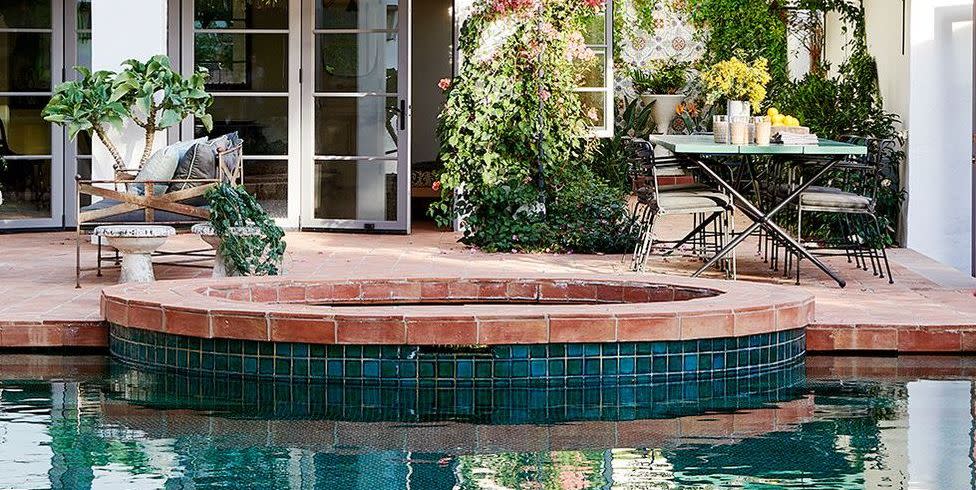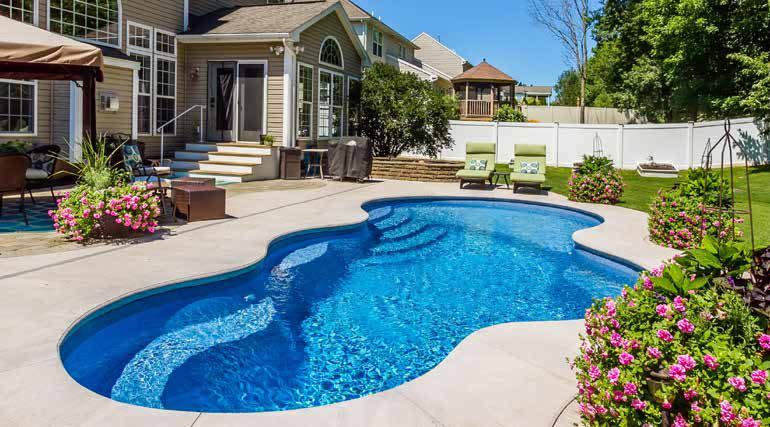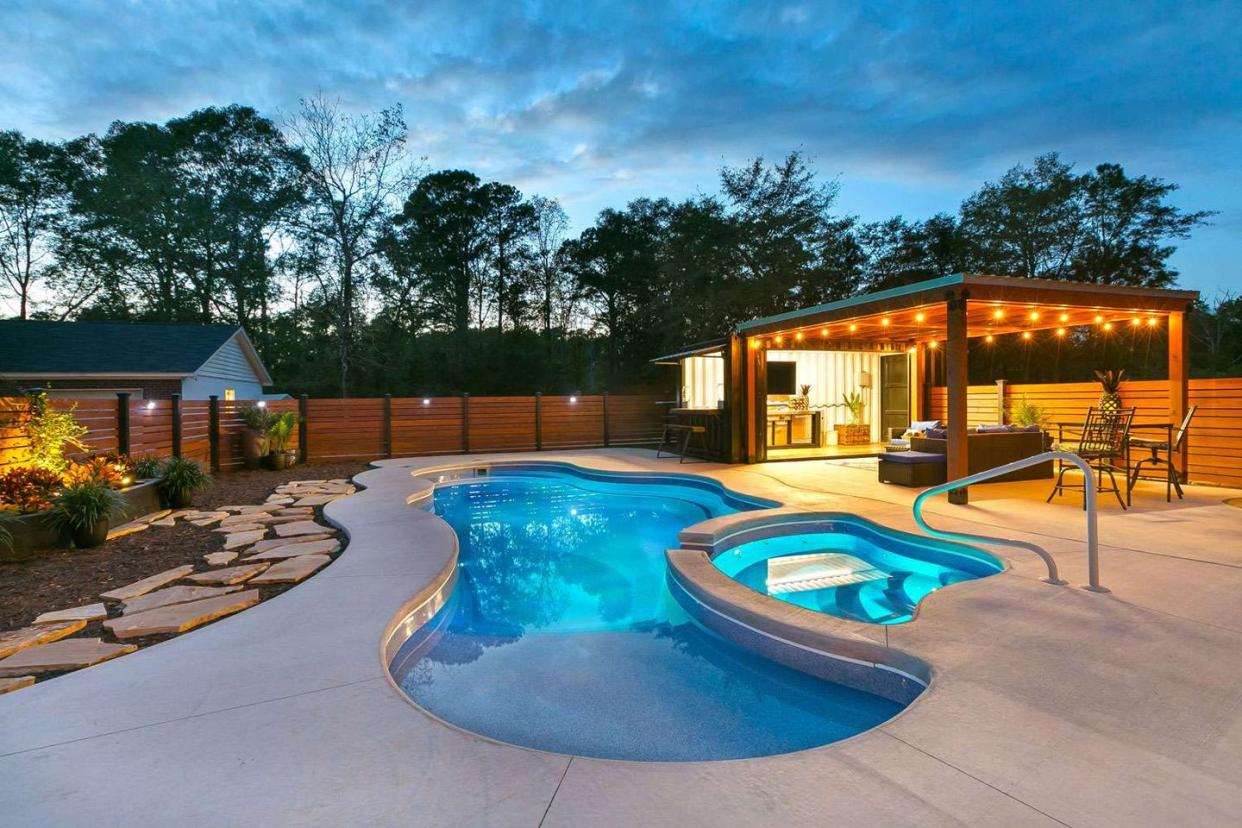Are Fiberglass Pools Worth It?

The best way to add warm-weather fun and increase your home's value simultaneously is to install a swimming pool. However, the costly (and labor intensive) process can deter many homeowners. So can the abundance of options. In ground, above ground, or stock tank? Vinyl lining or concrete frame? These days, a third swimming pool construction material is getting more and more popular: fiberglass. You may know it as the stuff helmets, boats, and insulation are made of, but it's a durable and affordable surface for pools too.
"Fiberglass pools are easier to clean than other pools, and their smooth surface prevents algae growth," says Sean Hurley, director of renovation and construction for America’s Swimming Pool Company. "They are also installed in one piece, making it your fastest option to begin enjoying the benefits of owning a pool." Ahead, we outline how much fiberglass pools cost, as well as the pros and cons of installing and maintaining one.
What Is A Fiberglass Pool?
Unlike vinyl or concrete pools, which are poured or placed and molded in the hole in your yard, fiberglass pools arrive premolded and ready for installation. (Picture a giant drop-in bathtub or baby pool.) This molded frame is made of fiberglass with a polyester resin (gel) coating. Fiberglass pools can last 25 to 30 years before needing repair, and they're much less likely to be damaged or punctured than a traditional vinyl pool liner.
How Much Do Fiberglass Pools Cost?
According to Hurley, fiberglass pools have an average total cost of $50,000 to $60,000, including construction but not landscaping. It's a big investment, but to put it in context, concrete and vinyl pools have even higher average starting costs: around $75,000.

Pros of a Fiberglass Pool
Environmentally Friendly
Fiberglass pools don't need chemical resurfacing or acid washing to remove stains the way concrete or vinyl pools do. And thanks to fiberglass's algae-resistant gel coating, the green stuff is less likely to build up, so you can use smaller amounts of chemicals to keep your pool water clean. That also means you'll be swimming in fewer chemicals and introducing fewer into the groundwater.
No Liner To Replace
Because there's no liner to begin with, fiberglass pool owners don't need to replace one every 10 years the way vinyl pool owners do. (Although concrete pools don't have a liner, they do require a complete resurfacing once a decade.) That also means your pool won't develop any pesky wrinkles or tears. Instead, a fiberglass pool has a hard fiberglass bottom and walls that stand up well to regular use and cleaning—no special treatment needed.
Lowest Lifetime Costs
Despite being more expensive to install than a traditional pool, a fiberglass pool doesn't require replacement liners or chemical refills. You'll likely spend less money on your pool after it's in the ground, which ultimately makes fiberglass a less expensive option than vinyl or concrete over the long term.
Most Durable
Fiberglass pools have a nonporous gel top coat that can't rip, tear, bunch up, or crack like vinyl or concrete. The standard gel coating can last 50 years or more without the need for resealing, replacing, or repairs. Fiberglass pools are great for areas that experience hot summers and cold winters because it won't warp or expand in extreme temperatures.
Fastest Installation
On average, a fiberglass pool takes only two to six weeks to install, start to finish. Vinyl pools take an average of six to eight weeks to install, according to River Pools and Spas, whereas a concrete pool installation can take three to six months.

Cons of a Fiberglass Pool
Expensive (And Involved) Installation
Because the fiberglass frame arrives as one large piece, it has to be lifted into your backyard by crane. Usually, it goes directly over the home rather than around. That calls for an abundance of specialists and caution to ensure everything goes smoothly. That's more costly than installing a vinyl liner or pouring concrete.
Potential Installation Damage
If your fiberglass pool's installation doesn't go smoothly, it could be a problem (for the pool frame itself, the roof of your house, and/or your landscaping). Damage doesn't happen often, but it's possible and might even be likely depending on how accessible your backyard is. It's always best to consult a few professionals before you make a final decision.
Limited Size and Shape Possibilities
Because of the way they're molded, fiberglass pools come in a limited number of shapes and sizes with very little custom options. For starters, fiberglass pools can't be wider than 16 feet. Anything wider than that can't be transported on the back of a truck. (You know when you get stuck behind a transport truck with a wide load sign? Whatever it's carrying has to be narrower than 16 feet—that's the limit.) While you can choose the interior surface color, you can't customize the depth or incorporate any add-ons like a baja shelf, tanning ledge, or additional staircases the way you can with a traditional vinyl or concrete pool.
The Final Verdict
Overall, fiberglass is a smart choice if you want a basic, low-maintenance pool. Fiberglass pools can't be customized to your exact size and shape specifications, and the expense and potential damage of installing one might send some homeowners running for the hills. However, if you have a backyard that's easy to access and don't care about custom features, low-maintenance fiberglass has obvious advantages over vinyl or concrete. It's perfect for colder climates, resistant to algae, and impervious to cracks and wrinkles.
You Might Also Like
